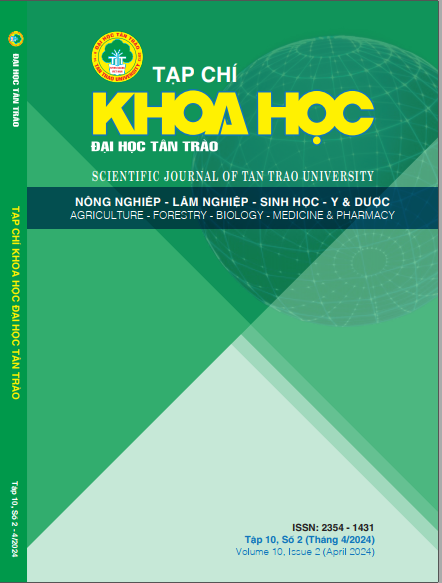SO SÁNH HIỆU QUẢ XỬ LÝ NƯỚC THẢI NUÔI TRỒNG THỦY SẢN GIỮA CÂY RAU NGỔ (Enydra fluctuans Lour) VÀ CÂY RAU MUỐNG (Ipomoea aquatica)
DOI:
https://doi.org/10.51453/2354-1431/2024/1092Tóm tắt
Nước thải nuôi trồng thủy sản có nồng độ chất ô nhiễm hữu cơ vừa phải rất thích hợp cho việc sử dụng thực vật thủy sinh để xử lý. Nghiên cứu được thực hiện với 3 nghiệm thức, trong đó rau muống và rau ngổ được chọn để xử lý nước thải có chiều cao trung bình khoảng 10 cm, trồng trong mô hình (thùng xốp) có mật độ 100 cây/m2. Kết quả nghiên cứu cho thấy rau ngổ và rau muống thích nghi và phát triển tốt trong môi trường nước thải nuôi lươn được đặc trưng bởi sự gia tăng các chỉ tiêu về sinh khối. Đặc biệt, khả năng xử lý chất ô nhiễm hữu cơ của cây rau muống cao hơn cây rau ngổ. Kết quả đạt được qua thí nghiệm như sau: Sau 20 ngày thí nghiệm, mật độ và sinh khối trung bình của rau muống tăng lần lượt là 1.32 và 4.9 lần, còn rau ngổ là 1.69 và 4 lần. pH nước thải sau xử lý dao động từ 7 ÷ 8. Tổng chất rắn lơ lửng (TSS) của nước thải sau xử lý giảm khoảng 78%. Nồng độ COD giảm 70% ở nghiệm thức trồng rau ngổ và 83% ở nghiệm thức trồng rau muống.
Tải xuống
Tài liệu tham khảo
Ali M, Billah M, Hassan M, Rahman S. M, and Al-Emran D (2013), “Enhydra fluctuans Lour: A Review”, Research Journal of Pharmacy and Technology, ISSN 0974-3618, pp. 927-929.
Asha P. T, Jayalekshmi S. J, Minnu B, Jithin S, Muhammad A. I (2021). Aquaculture wastewater treatment technologies and their sustainability: A review. Energy Nexus 4 100022. https://doi.org/10.1016/j. nexus.2021.100022
Enduta A, Jusoh A, Ali N, Wan Nik W. B (2012), Nutrient removal from aquaculture wastewater by vegetable production in aquaponics
recirculation system, Desalination and Water Treatment, Volume 32, Issue 1-3, pp 422-430.
Nagendra Prasad K, Sivamurthy G. R, Aradhya S. M (2008), Ipomoea aquatica, An Underutilized Green Leafy Vegetable: A Review; International
Journal of Botany 4 (1): 123-129, ISSN 1811- 9700.
Nguyen Minh Phuong, Nguyen Huu Hung, Tran Minh Kha, Cung Phuong Hoa (2023), Study on Aquaculture Wastewater Treatment by Aquatic Plants. VNU Journal of Science: Earth and Environmental Sciences, Vol. 39, No. 4
-62. https://doi.org/10.25073/2588-1094/ vnuees.4995.
Nizam N. U. M, Anafiah M. M, Noor I. M, Karim H. I. A (2020). Efficiency of Five Selected Aquatic Plants in Phytoremediation of Aquaculture Wastewater. Applied Sciences, Vol. 10, pp. 1-11. https://doi.org/10.3390/ app10082712
Nuwansi K. K. T, Verma A. K, Prakash C, Prabhath G. P. A, R. Peter M (2018)., Performance Evaluation and Phytoremediation Efficiency of Selected Aquatic Macrophytes on Aquaculture Effluent. Journal of Entomology and Zoology Studies, Vol. 6, No. 2, pp. 2885- 2891. https://doi.org/10.1016/j.heliyon.2022. e10093 OECD/FAO (2018). OECD-FAO agricultural outlook. OECD agriculture statistics (database).10.1787/agr-outl-data-en.
Pham Khanh Huy, Do Cao Cuong, Nguyen Mai Hoa, Nguyen Pham Hong Lien (2012). Using aquatic system with hyacinth to treat domestic
wastewater. Journal of Mining and Earth Sciences, Vol 40, pp 16-22.
Putu C. Delis, Hefni Effendi, Majariana Krisanti, Sigid Hariyadi (2015), Treatment of aquaculture wastewater using Vetiveria zizanioides (Liliopsida, Poaceae), Scholarly Journal; Aquaculture, Aquarium, Conservation & Legislation; Vol. 8, Iss. 4: 616-625.
QCVN 08:2023/BTNMT. National technical regulation on Surface water quality. Ministry of Natural Resources and Environment.
Tran Thi Bich Nhu, Nguyen Thi Hong Van, Tran Thi Be, Le My Phuong (2022). Operating aquaponic system in BacLieu University. TNU Journal of Science and Technology. 228(05): 97 - 104. https://doi.org/10.34238/tnu-jst.7160
VASEP (Vietnam Association of Seafood Exporters and Producers), 01/11/2022. Seafood exports in the first 10 months of the year was reached 9.5 billion USD. Web: https://vasep. com.vn/. [Accessed July 2023].
Tải xuống
Đã Xuất bản
Cách trích dẫn
Số
Chuyên mục
Giấy phép

Tác phẩm này được cấp phép theo Giấy phép Quốc tế Creative Commons Attribution-ShareAlike 4.0 .
Bài báo được xuất bản ở Tạp chí Khoa học Đại học Tân Trào được cấp phép theo giấy phép Ghi công - Chia sẻ tương tự 4.0 Quốc tế (CC BY-SA). Theo đó, các tác giả khác có thể sao chép, chuyển đổi hay phân phối lại các bài báo này với mục đích hợp pháp trên mọi phương tiện, với điều kiện họ trích dẫn tác giả, Tạp chí Khoa học Đại học Tân Trào và đường link đến bản quyền; nêu rõ các thay đổi đã thực hiện và các nghiên cứu đăng lại được tiến hành theo cùng một bản quyền.
Bản quyền bài báo thuộc về các tác giả, không hạn chế số lượng. Tạp chí Khoa học Tân Trào được cấp giấy phép không độc quyền để xuất bản bài báo với tư cách nhà xuất bản nguồn, kèm theo quyền thương mại để in các bài báo cung cấp cho các thư viện và cá nhân.
Mặc dù các điều khoản của giấy phép CC BY-SA không dành cho các tác giả (với tư cách là người giữ bản quyền của bài báo, họ không bị hạn chế về quyền hạn), khi gửi bài tới Tạp chí Khoa học Đại học Tân Trào, tác giả cần đáp ứng quyền của độc giả, và cần cấp quyền cho bên thứ 3 sử dụng bài báo của họ trong phạm vi của giấy phép.






